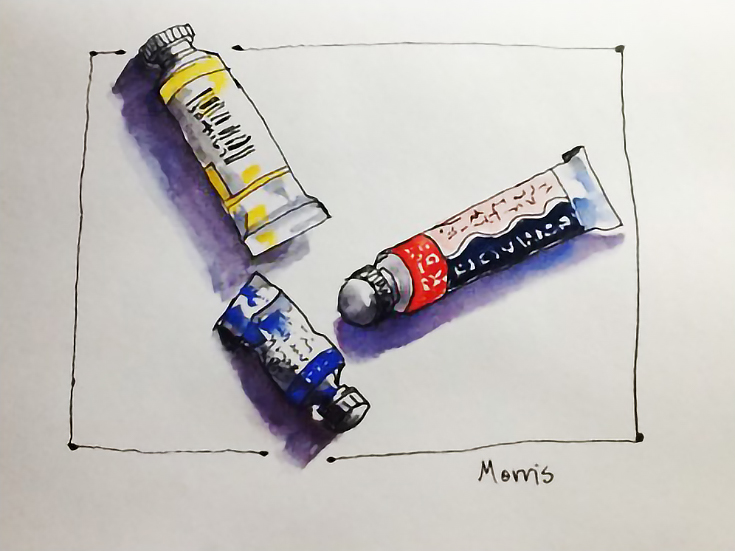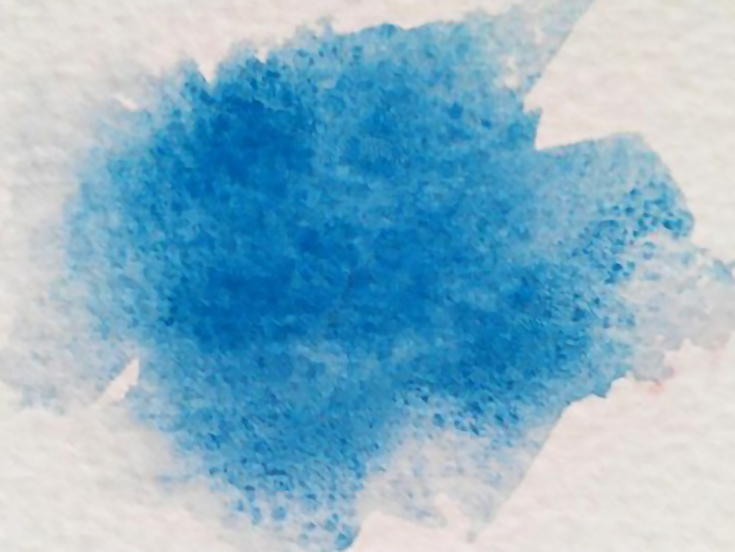Watercolor paint can be pure and lively or soft and watery—and no matter how you paint, it has several unique color qualities that make it different from other mediums.
Furthermore, each manufacturer of watercolors is different, and will mark their paint colors with different codes (or have a chart where you can look up their colors) so you’ll know more about a particular paint color before you use it.
Here are some of the different qualities that watercolor paints can have:
Granulating or non-granulating pigments
Watercolor paints are dry, ground-up pigments mixed with binders and put in a tube (or a pan). Because watercolor paint is used with, and reacts to, the water and paper, certain pigments behave differently than others.
Non-granulating pigments are those that react smoothly and evenly with water. They tend to cover the paper equally, with little or no variation in color and texture.
Other pigments we use are granulating, which means that when water is added the pigments separate from the binder and settle into the “valleys” of the paper. As it dries in the “valleys” it leaves a grainy texture.
If a texture or an uneven wash is needed, granulating paints can be used with great effect. Granulating paints also separate when mixed with other colors and do wonderful things. A few of more frequently used granulating colors would be Cerulean and the Ultramarine blues, as well as Raw Sienna, Burnt Sienna and Burnt Umber.
If you’re not interested in having this kind of visual variation in your paint, its best to stay away from these granulating pigments—but more often than not, you just need to be aware that these particular colors WILL have a more textured quality to them.
Transparent or opaque pigments
While all watercolors are transparent when used with enough water, some are also naturally more opaque. A transparent color lets the white of the paper (or whatever you painted underneath it) show through, while other pigments are denser, with more ability to cover what’s underneath.
Many lower quality watercolors are mixed with more binder and less pigment and will also appear chalky and opaque. Opaque colors lack vibrancy and if overused can absolutely kill a painting! I don’t use opaque colors often, and you wont find many on my palette. (Raw Sienna is one I that I do use frequently.)
You can check the manufacturer code to see if a paint is Opaque or Semi Opaque, but you can also use this simple test:
Using a black Sharpie marker (broad tip) draw a solid line across your watercolor paper. Using a paint mixture that is not terribly watery (but not as thick as it is straight from the tube) paint a strip or square of color on top of the line. After the paint dries, you will either see a residue of paint on the line (an opaque paint) or the paint will disappear on it (a transparent paint).
Of course, adding more water to your mixture will give you more transparency . . . and at times you may want to do that with some of your more opaque colors. Conversely, you can also paint straight from the tube for your more transparent colors, so that they cover better.
Staining or non-staining pigments
A staining pigment means exactly what it says—once applied, it will sink quickly into the fibers of the paper making it difficult to “lift” or remove. The paper will be stained that color, and in some cases, so will your palette and brushes.
Non-staining pigments sit on top of the paper and can be removed much more easily by re-wetting the paper and scrubbing (not too hard!) to lift the paint.
You will learn over time which colors are staining, but you can also easily test them yourself by painting squares of color on paper (the same consistency as before—not to watery, and not to thick) and allowing them to dry overnight for the paper to thoroughly absorb the paint.
The next day run the paper under water and use a clean brush to gently scrub the paint swatches and rinse off the paint. Any colors that sit on the surface of the paper will come off, but those that sink into the fiber of the paper will leave a stain. (Most manufactures include this info on their color charts or paint tubes as well.)
So if you haven’t already, try a few of these simple tests this week. It won’t take long to become more familiar with what your paint colors will do.
I realize it’s not as fun as simply sitting down and creating a painting, but your growing awareness of the types of paint on your palette (and how you can work with them) will greatly improve your future paintings.
Have fun, and happy painting!
This post may contain affiliate links.



